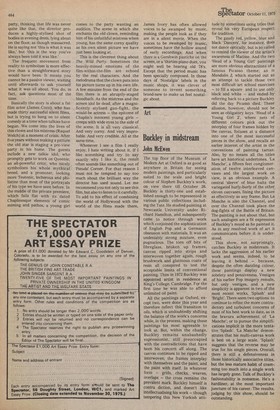Art
Buckley in midstream Joh &Ewen
The top floor of the Museum of Modern Art at Oxford is as good as anywhere in Britain for seeing modern paintings, and particularly suited to the scale and bright colour of Stephen Buckley's work, on view there till October 26. Buckley is thirty-one and established enough to be represented in various public collections including the Tate. He studied painting at Newcastle University under Richard Hamilton, and subsequently came to notice through work which conjoined the sophistication of English Pop and a Germanic obsession with materials. It was an undeniably strong mixture, even pugnacious. The torn off bits of fibreglass, broken up frames, canvas ripped into strips and interwoven together again, rough brushwork and glutinous coats of resin all conspired to test the acceptable limits of conventional painting. Then in 1972 Buckley was appointed artist in residence at King's College, Cambridge. For the first time he was able to afford unlimited oil paint.
All the paintings at Oxford, except two, were done this year and therefore reflect this transition to oils, which is undoubtedly shifting the balance of the work's concerns while, in the process, making these paintings his most agreeable to look at. But, within the change, Buckley remains unabashedly expressionist, still preoccupied with the contradictions that have been his concern all along. The canvas continues to be ripped and interwoven; the frames interplay with themselves and the paint, and the paint with itself. In whatever form — grids, checks, weaves, overlaps — the cross remains the prevalent mark. Buckley himself is contra diction, and doesn't like intellectualising his work — though tempering this New Yorkish atti tude by sometimes using titles that reveal his very European respect for tradition.
The gaudy red, yellow, blue and black 'Dancers', for instance, does not dance optically, but is so called to remind the viewer of the artist's awareness of Matisse. And the two 'Head of a Young Girl' paintings are more obvious abstractions of a famous Picasso theme; as is Mandolin 2, which started out as an attempt to tackle those two most difficult art school exercises — to fill a square and to use only black and white — and endedby referring back to a picture Buckley did the day Picasso died. These allusion, however, should not be seen as obligatory keys. 'Head of a Young Girl 2', where nets of different colours pick out the interplay of four frames hidden by the canvas, focuses at a distance into one of the most successful pieces in the show, and recalls an earlier interest of the artist in the conventions of painting tartan. Also, by no means all the titles have art historical undertones. 'La Manche', a fifteenfeet conglomeration of twelve interleaved canvases and the largest work on view, is an obvious example. A central 'sleeve' of blue halts the variegated hurly-burly of the other eleven canvases, fixing the picture as effectively as any frame. But La Manche is also the Channel, and over the Channel took place the dog-fights of the Battle of Britain. The painting is not about that, but such analogies are a fit expression of Buckley's mood as he painted it. As in any resolved work of art it communicates before it is understood.
This show, not surprisingly, catches Buckley in midstream. It lacks the aggression of his earlier work and seems, indeed, to be leaving it behind — because, despite the often dazzling colour, these paintings display a new sobriety and pensiveness. Vestiges of his earlier Pop imagery remain, but only vestiges, and a new simplicity is apparent in two of the most recent works, 'Splash' and 'Bright'. There seem two options: to continue to refine the more contradictory and turbulent concerns of most of his best work to date, as in the bravura achievement of 'La Manche': or to pursue the simplifications implicit in the more tentative 'Splash'. `La Manche' demonstrates that his multi-canvas work is best on a large scale. 'Splash' suggests that the reverse may be true for his single pieces. Overall, there is still a defensiveness in those historically associative titles, but the less mature habit of cramming too much into a single work has largely gone,. Talk of Buckley's fashionability is nonsense. He's a hardliner, at the most important juncture of his career. The results, judging by this show, should be outstanding.


































 Previous page
Previous page